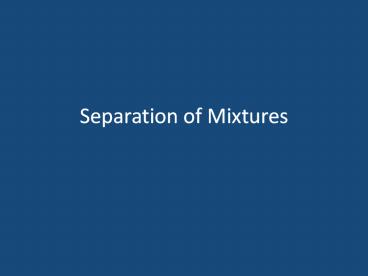Separation%20of%20Mixtures - PowerPoint PPT Presentation
Title:
Separation%20of%20Mixtures
Description:
Separation of Mixtures Separation of Mixtures Mixtures, both homogeneous and heterogeneous, can be separated by physical changes. Techniques used for separating ... – PowerPoint PPT presentation
Number of Views:283
Avg rating:3.0/5.0
Title: Separation%20of%20Mixtures
1
Separation of Mixtures
2
Separation of Mixtures
- Mixtures, both homogeneous and heterogeneous, can
be separated by physical changes.
3
Techniques used for separating mixtures
- Separation by physical properties
- Filtration
- Distillation
- Crystallization
- Evaporation to dryness
- Chromatography
4
Separation by properties
- Physical characteristics such as color, size,
density, magnetism, etc can be used to separate
mixtures. - Example separating iron from a mixture.
- separating a layer of oil from water
- separating red marbles from blue marbles
5
Separation by filtration
- Heterogeneous mixtures composed of insoluble
solids in liquids are easily separated by
filtration. - Equipment used during this process includes a
funnel and filter paper. - The liquid which passes through the filter paper
is called the filtrate. - Example sand in water
6
Evaporation to dryness.
- Homogeneous mixtures composed of dissolved solids
in a solvent can be separated by boiling off the
liquid. The solute remains in the evaporating
dish. - Equipment required involves a hot plate and
evaporating dish. - Example salt dissolved in water
7
Distillation
- Distillation is used to separate a solution of
two liquids. It is based on differences in the
boiling points of the two substances involved. - When the solution is heated, the substance with
the lowest boiling point boils and changes to a
vapor. The vapor condenses as it passes through
the condenser and is collected. - Example separating water from the syrup in a
coke. - separating alcohol from water
8
Distillation
9
Crystallization
- A solution containing a dissolved solute can also
be separated using crystallization. - When the solution contains as much of the
dissolved substance as possible, the addition of
even a tiny amount can cause the dissolved
substance to come out of solution and collect on
any available surface. - Example the making of rock candy from a sugar
solution.
10
Crystallization
11
Chromatography
- Chromatography is a technique that separates two
liquid components of mixture from each other
based on the ability of each substance to travel
up the surface of another material (called the
stationary phase). - The stationary phase is often a solid such as the
chromatography paper. - Components with the strongest attraction for the
paper travel slower. - Example separating dyes in food coloring
12
Chromatography
13
How would a mixture of two colorless liquids be
separated?
- Chromatography
- Distillation
- Evaporation to Dryness
- Filtration
1 2 3 4 5 6 7 8 9 10 11 12 13 14 15 16 17 18 19 20
21 22 23 24 25 26 27 28 29 30
14
What is the most efficient way of separating a
non-dissolving solid from a liquid?
- Chromatography
- Distillation
- Evaporation to Dryness
- Filtration
1 2 3 4 5 6 7 8 9 10 11 12 13 14 15 16 17 18 19 20
21 22 23 24 25 26 27 28 29 30
15
What technique should be used to separate a
mixture of red and blue marbles of the same size
and mass?
- Chromatography
- Distillation
- Filtration
- Separation by Properties
1 2 3 4 5 6 7 8 9 10 11 12 13 14 15 16 17 18 19 20
21 22 23 24 25 26 27 28 29 30
16
How can you separate the components of paint?
- Chromatography
- Distillation
- Evaporation to Dryness
- Filtration
1 2 3 4 5 6 7 8 9 10 11 12 13 14 15 16 17 18 19 20
21 22 23 24 25 26 27 28 29 30
17
How can you separate vinegar and oil?
- Chromatography
- Evaporation to Dryness
- Filtration
- Separation by Properties
1 2 3 4 5 6 7 8 9 10 11 12 13 14 15 16 17 18 19 20
21 22 23 24 25 26 27 28 29 30
18
How would you separate vinegar from water?
- Chromatography
- Distillation
- Evaporation to Dryness
- Filtration
1 2 3 4 5 6 7 8 9 10 11 12 13 14 15 16 17 18 19 20
21 22 23 24 25 26 27 28 29 30
19
Distillation results in the formation of solid
particles of a dissolved substance?
- True
- False
1 2 3 4 5 6 7 8 9 10 11 12 13 14 15 16 17 18 19 20
21 22 23 24 25 26 27 28 29 30
20
Filtration depends on differences in sizes of
particles.
- True
- False
1 2 3 4 5 6 7 8 9 10 11 12 13 14 15 16 17 18 19 20
21 22 23 24 25 26 27 28 29 30
21
Separations of mixtures depend on the chemical
properties of the substances involved.
- True
- False
1 2 3 4 5 6 7 8 9 10 11 12 13 14 15 16 17 18 19 20
21 22 23 24 25 26 27 28 29 30
22
Chromatography depends on the different boiling
points.
- True
- False
1 2 3 4 5 6 7 8 9 10 11 12 13 14 15 16 17 18 19 20
21 22 23 24 25 26 27 28 29 30
23
Evaporation to dryness can be used to separate
two liquids.
- True
- False
1 2 3 4 5 6 7 8 9 10 11 12 13 14 15 16 17 18 19 20
21 22 23 24 25 26 27 28 29 30































